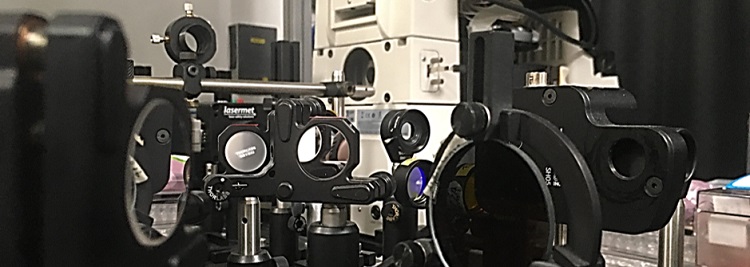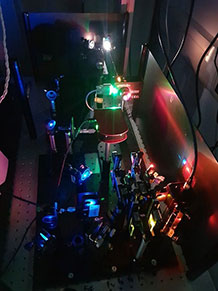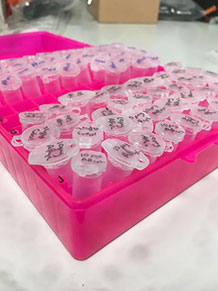
Biological Nanosystems Laboratory: Unveiling the Molecular Nanoworld of Life and Disease using Optics, Spectroscopy and Single-Molecule Fluorescence Microscopy
- We are a team of highly interdisciplinary researchers working at the interface of biophysics and single-molecule microscopy to investigate the molecular nanoworld of human life and disease.
- We leverage major technological developments in microscopy with novel biochemical approaches to answer major open questions related to dementia.
- Our lab focuses on detecting, understanding and exploiting protein, DNA and model-membrane systems to access new information about disease pathology on the nanoscale.
- Our goal is to provide a new suite of biophysical tools from which to more effectively and efficiently screen and design the next-generation of therapeutics.

The Biological Nanosystems team is headed by Dr. Steven Quinn, Alzheimer’s Research UK Fellow and Lecturer in Biophysics.
Steven Quinn is a lecturer specializing in multidisciplinary science across the life-sciences interface. His work combines recent advances in biochemistry with state-of-the-art microscopy tools to probe the molecular building blocks of human life and disease. His focus is on the application of advanced single-molecule fluorescence microscopy techniques to investigate biological processes related to Alzheimer’s disease at the nanoscale. Steven completed his PhD at the University of St Andrews, and held research positions at the University of Glasgow and the Massachusetts Institute of Technology (MIT).
Single-molecule biophysics: lighting a path towards a more quantitative framework of thinking across the life-sciences. Photocredit: Sebastian Guilbaud
Research in Steven’s lab combines tools from optics and spectroscopy, biology and microscopy to probe the nanoscale interactions and dynamics of biomolecules. His primary experimental approaches combine fluorescence microscopy tools, such as total internal reflection fluorescence (TIRF) imaging, with cutting-edge biophysical and biochemical techniques to explore protein-protein interactions implicated in dementia. These include interactions with model membrane nanosystems (lipid vesicles, nanodiscs and supported membrane bilayers) and living cells, to evaluate how they cluster and form toxic nanopores. He has a particular interest in understanding protein nucleation processes and how these can trigger the death of nerve cells.
Understanding Alzheimer’s disease, one molecule at a time
His early work led to the development of new approaches for monitoring self-assembly of the b-amyloid protein, and for the screening of novel oligomerization inhibitors. He has also investigated the effect of molecular crowding agents on biomolecular structure, developed tools and techniques for exploring carbohydrate interactions and created a series of sensing platforms for detecting toxic agents in solution. Recent work has focussed on the development of fluorescently tagged model membrane vesicles and membrane nanodiscs for exploring protein-lipid interactions and membrane disruption mechanisms.
Key Publications:
P. A. Dalgarno, J. Juan-Colas, G. J. Hedley, L. Pineiro, M. Novo, D. C. Perez Gonzalez, I. D. W. Samuel, M. C. Leake, W. Al-Soufi, S. Johnson, J. C. Penedo & S. D. Quinn† . Unveiling the multi-step solubilization mechanism of sub-micron size vesicles by detergents. Sci. Rep. 9, 12897 (2019).
S.D. Quinn, S. Srinivasen, J. Gordon, W. He, K. L. Carraway, III, M. A. Coleman & G. S. Schlau-Cohen. Single-molecule fluorescence detection of the epidermal growth factor receptor in membrane discs. Biochemistry. 58, 286-294 (2018).
S.D. Quinn & S. W. Magennis. Optical detection of gadolinium (III) ions via quantum dot aggregation. RSC Advances. 7, 24730-24735 (2017).
S.D. Quinn, A. Rafferty, E. Dick, M. J. Morten, F. J. Kettles, C. Knox, M. Murrie & S. W. Magennis. Surface charge control of quantum dot blinking. J. Phys. Chem. C. 120, 19487-19491 (2016)
C. E. Dalton*, S. D. Quinn*, A. Rafferty, M. J. Morten, J. M. Gardiner & S. W. Magennis. Single-molecule fluorescence detection of a synthetic heparan sulfate disaccharide. ChemPhysChem. 17, 3442-3446 (2016).
L. Aitken, S. D. Quinn, D. C. Perez-Gonzalez, I. D. W. Samuel, J. C. Penedo and F. J. Gunn-Moore. Morphology-specific inhibition of b-amyloid aggregates by 17b-hydroxysteroid dehydrogenase type 10. ChemBioChem, 17, 1029-1037 (2016).
L. E. Baltierra-Jasso, M. J. Morten, L. Laflör, S. D. Quinn & S. W. Magennis. Crowding-induced hybridization of single DNA hairpins. J. Am. Chem. Soc. 137, 16020-16023 (2015).
R. T. Cameron, S. D. Quinn, L. S. Cairns, R. MacLeod, I. D. W. Samuel, B. O. Smith, J. C. Penedo & G. S. Baillie. The phosphorylation of Hsp20 enhances its association with amyloid-b to increase protection against neuronal cell death. Mol. Cell. Neurosci. 61, 46-55 (2014).
S.D. Quinn, P. A. Dalgarno, R. T. Cameron, G. J. Hedley, C. Hacker, J. M. Lucocq, G. S. Baillie, I. D. W. Samuel & J. C. Penedo. Real-time probing of b-amyloid self-assembly and inhibition using fluorescence self-quenching between neighbouring dyes. Mol. Biosyst. 10, 34-44 (2014).


